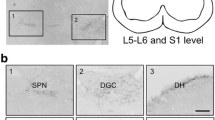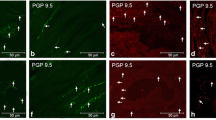Abstract
The present study investigated the influence of castration performed at neonatal age on neuronal elements in the anterior pelvic ganglion of the male pig with immunohistochemistry and quantitative real-time PCR (qPCR). The ganglia were examined 3 and 6 months after surgery. In 3-month-old castrated pigs (3MCP) 74% of adrenergic and 31% of cholinergic neurons stained for caspase-3 (CASP-3), and much greater numbers of perikarya than in the control animals expressed CGRP, galanin (GAL) and VIP (peptides known to have neuroprotective properties). In 6-months-old castrated pigs (6MCP), an excessive loss (90%) of neurons and intraganglionic nerve fibres was found. The survived adrenergic and cholinergic neurons also expressed CASP-3, CGRP, GAL or VIP. The qPCR results corresponded with immunofluorescence findings. In 3MCP, genes for CASP-3 and CGRP were up-regulated, while the expression of those for DβH, VAChT, GAL, VIP and SP displayed statistically insignificant variations. In 6MCP, distinctly up-regulated were genes for CGRP, GAL, VIP, SP, DβH and VAChT, while the expression of casp3 gene was down-regulated. The study revealed for the first time the excessive loss of pelvic neurons following castration, and a realistic assumption is proposed, that the neurons died due to apoptosis triggered by androgen deprivation.
















Similar content being viewed by others
References
Abushik PA, Bart G, Korhonen P et al (2017) Pro-nociceptive migraine mediator CGRP provides neuroprotection of sensory, cortical and cerebellar neurons via multi-kinase signaling. Cephalalgia 37:1373–1383
Blesch A, Tuszynski MH (2001) GDNF gene delivery to injured adult CNS motor neurons promotes axonal growth, expression of the trophic neuropeptide CGRP, and cellular protection. J Comp Neurol 436:399–410
Cheng Y, Yu L-C (2010) Galanin protects amyloid-β-induced neurotoxicity on primary cultured hippocampal neurons of rats. J Alzheimer’s Dis 20:1143–1157
Deng G, Jin L (2017) The effects of vasoactive intestinal peptide in neurodegenerative disorders. Neurol Res 39:65–72
Dubreuil P, Pelletier G, Couture Y et al (1989) Castration and testosterone effects on endogenous and somatocrinin-induced growth hormone release in intact and castrated male pigs. Domest Anim Endocrinol 6:15–24
Ford JJ (1983) Postnatal differentiation of sexual preference in male pigs. Horm Behav 17:152–162
Ford JJ, D’Occhio MJ (1989) Differentiation of sexual behavior in cattle, sheep and swine. J Anim Sci 67:1816–1823
Ford JJ, Christenson RK, Maurer RR (1980) Serum testosterone concentrations in embryonic and fetal pigs during sexual differentiation. Biol Reprod 23:583–587
Heberden C (2017) Sex steroids and neurogenesis. Biochem Pharmacol 141:56–62
Hobson S-A, Bacon A, Elliot-Hunt CR et al (2008) Galanin acts as a trophic factor to the central and peripheral nervous systems. Cell Mol Life Sci 65:1806–1812
Huang X-Z, Park J-T, Kim H-G et al (2011) Phenotype-specific down-regulation of nicotinic acetylcholine receptors in the pelvic ganglia of castrated rats: implications for neurogenic erectile dysfunction. Neurosci Lett 501:55–59
Kaleczyc J (1998) Origin and neurochemical characteristics of nerve fibres supplying the mammalian vas deferens. Microsc Res Tech 42:409–422. https://doi.org/10.1002/(SICI)1097-0029(19980915)42:6%3c409:AID-JEMT4%3e3.0.CO;2-H
Kaleczyc J, Timmermans JP, Majewski M et al (1999) Immunohistochemical properties of nerve fibres supplying accessory male genital glands in the pig. A colocalisation study. Histochem Cell Biol 111:217–228
Kaleczyc J, Sienkiewicz W, Klimczuk M et al (2003) Differences in the chemical coding of nerve fibres supplying major populations of neurons between the caudal mesenteric ganglion and anterior pelvic ganglion in the male pig. Folia Histochem Cytobiol 41:201–211
Kaleczyc J, Kasica-Jarosz N, Pidsudko Z et al (2019) The expression of androgen receptor in neurons of the anterior pelvic ganglion and celiac-superior mesenteric ganglion in the male pig. Pol J Vet Sci 22:151–155
Kanjhan R, Osborne PB, Ouyang M, Keast JR (2003) Postnatal maturational changes in rat pelvic autonomic ganglion cells: a mixture of steroid-dependent and -independent effects. J Neurophysiol 89:315–323
Kasica-Jarosz N, Podlasz P, Kaleczyc J (2018) Pituitary adenylate cyclase-activating polypeptide (PACAP-38) plays an inhibitory role against inflammation induced by chemical damage to zebrafish hair cells. PLoS ONE 13:e0198180
Keast JR (1995) Visualization and immunohistochemical characterization of sympathetic and parasympathetic neurons in the male rat major pelvic ganglion. Neuroscience 66:655–662
Keast JR (2000) Effects of testosterone on pelvic autonomic pathways: progress and pitfalls. J Auton Nerv Syst 79:67–73
Keast JR, de Groat WC (1989) Immunohistochemical characterization of pelvic neurons which project to the bladder, colon, or penis in rats. J Comp Neurol 288:387–400. https://doi.org/10.1002/cne.902880303
Keast JR, Gleeson RJ (1998) Androgen receptor immunoreactivity is present in primary sensory neurons of male rats. NeuroReport 9:4137–4140
Keast JR, Saunders RJ (1998) Testosterone has potent, selective effects on the morphology of pelvic autonomic neurons which control the bladder, lower bowel and internal reproductive organs of the male rat. Neuroscience 85:543–556
Keast JR, Luckensmeyer GB, Schemann M (1995) All pelvic neurons in male rats contain immunoreactivity for the synthetic enzymes of either noradrenaline or acetylcholine. Neurosci Lett 196:209–212
Lacorn M, Bauer A, Claus R (2009) Is the early postnatal rise of testosterone responsible for a later male pattern of growth hormone secretion in pigs? Theriogenology 72(5):636–642
Listowska Z, Pidsudko Z (2018) Axotomy-induced plasticity of cranial pelvic ganglia neurons (CPG) supplying urinary bladder trigone (UBT) in the male pig. Anat Histol Embryol 47:49
Lossi L, Castagna C, Merighi A (2018) Caspase-3 mediated cell death in the normal development of the mammalian cerebellum. Int J Mol Sci 19:3999
Marrocco J, McEwen BS (2016) Sex in the brain: hormones and sex differences. Dialog Clin Neurosci 18:373–383
Melvin JE, Hamill RW (1987) The major pelvic ganglion: androgen control of postnatal development. J Neurosci 7:1607–1612
Melvin JE, Hamill RW (1989a) Androgen-specific critical periods for the organization of the major pelvic ganglion. J Neurosci 9:736–742
Melvin JE, Hamill RW (1989b) Hypogastric ganglion perinatal development: evidence for androgen specificity via androgen receptors. Brain Res 485:11–19
Melvin JE, McNeill TH, Hamill RW (1988) Biochemical and morphological effects of castration on the postorganizational development of the hypogastric ganglion. Brain Res 466:131–139
Melvin JE, McNeill TH, Hervonen A, Hamill RW (1989) Organizational role of testosterone on the biochemical and morphological development of the hypogastric ganglion. Brain Res 485:1–10
Moya S, Boyl L, Lynch P, Arkins S (2008) Effect of surgical castration on the behavioural and acute phase responses of 5-day-old piglets. Appl Anim Behav Sci 111:133–145
Pidsudko Z (2014) Immunohistochemical characteristics and distribution of neurons in the paravertebral, prevertebral and pelvic ganglia supplying the urinary bladder in the male pig. J Mol Neurosci 52:56–70
Schwarzenberger F, Toole GS, Christie HL, Raeside JI (1993) Plasma levels of several androgens and estrogens from birth to puberty in male domestic pigs. Acta Endocrinol (Copenh) 128:173–177
Sienkiewicz W (2010a) Immunohistochemical properties of caudal mesenteric ganglion and anterior pelvic ganglion neurons projecting to the porcine testes subjected to hemi castration, castration and testosterone supplementation. Bull Vet Inst Pulawy 54:357–367
Sienkiewicz W (2010b) Sources of the porcine testis innervation. Andrologia 42:395–403
Sienkiewicz W, Dudek A, Kaleczyc J, Chrószcz A (2010) Immunohistochemical characterization of neurones in the hypoglossal nucleus of the pig. Anat Histol Embryol 39:152–159
Slee EA, Adrain C, Martin SJ (2001) Executioner caspase-3, -6, and -7 perform distinct, non-redundant roles during the demolition phase of apoptosis. J Biol Chem 276:7320–7326
Spigelman I, Puil E (1991) Substance P actions on sensory neurons. Ann N Y Acad Sci 632:220–228
Squillacioti C, De Luca A, Paino G, Mirabella N (2008) Effects of castration on the immunoreactivity to NGF, BDNF and their receptors in the pelvic ganglia of the male rat. Eur J Histochem 52:101–106
Tunçel N, Korkmaz OT, Tekin N et al (2012) Antioxidant and anti-apoptotic activity of vasoactive intestinal peptide (VIP) against 6-hydroxy dopamine toxicity in the rat corpus striatum. J Mol Neurosci 46:51–57
Watkins TW, Keast JR (1999) Androgen-sensitive preganglionic neurons innervate the male rat pelvic ganglion. Neuroscience 93:1147–1157
Acknowledgments
Project financially co-supported by Minister of Science and Higher Education in the range of the program entitled "Regional Initiative of Excellence" for the years 2019–2022, Project No. 010/RID/2018/19, amount of funding 12.000.000 PLN.
Author information
Authors and Affiliations
Corresponding author
Ethics declarations
Conflict of interest
The authors declare that they have no conflict of interest.
Additional information
Publisher's Note
Springer Nature remains neutral with regard to jurisdictional claims in published maps and institutional affiliations.
Rights and permissions
About this article
Cite this article
Kaleczyc, J., Kasica-Jarosz, N., Pidsudko, Z. et al. Effect of castration on pelvic neurons in the male pig. Histochem Cell Biol 153, 135–151 (2020). https://doi.org/10.1007/s00418-019-01837-w
Accepted:
Published:
Issue Date:
DOI: https://doi.org/10.1007/s00418-019-01837-w




